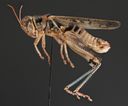Spur-throated Grasshoppers
Melanoplinae
Classification
- Phylum: Arthropoda
- Subphylum: Hexapoda
- Class: Insecta
- Order: Orthoptera
- Suborder: Caelifera
- Family: Acrididae
- Subfamily: Melanoplinae
Pronunciation
How to pronounce Melanoplinae: /ˌmɛləˈnɔplaɪniː/
These audio files are automatically generated. While they are not always 100% accurate, they are a good starting point.
Images






Summary
The Melanoplinae, often referred to as spur-throated grasshoppers, are a diverse and widely distributed subfamily of grasshoppers found primarily in the Americas. With over 100 recognized genera and a significant number of species, they play vital roles in their habitats and possess a range of adaptations.
Physical Characteristics
The Melanoplinae are characterized by their spur-like projections on the throat (hence the name 'spur-throated'). They exhibit significant morphological diversity, with variations among tribes and genera, often adapted to their specific habitats and ecological niches.
Identification Tips
Identification can often be based on physical features such as body size, shape, coloration, and the presence of spur-like structures on the throat. Detailed morphological comparisons with closely related genera and species may be necessary to accurately identify individuals, especially since genera within tribes can vary greatly in appearance.
Habitat
Melanoplinae grasshoppers are typically found in open areas with vegetation near the ground, often in sunny locations. However, they can also be found in a variety of habitats including rocky barrens, trees, and shaded areas within forests.
Distribution
The subfamily Melanoplinae is broadly distributed across the Holarctic and Neotropical regions, with most species occurring in the Americas. The tribes primarily inhabit North America, while some tribes are located in South America.
Diet
Melanoplinae grasshoppers are primarily herbivorous, feeding on various types of plants and grasses. They play a role in their ecosystems as primary consumers.
Life Cycle
In the northern regions, typically, there is one annual generation. They overwinter as eggs laid in the ground or in other substrates, hatching in spring or early summer. Adult grasshoppers can be found from spring until frost.
Reproduction
Reproduction involves the laying of eggs in the ground or other solid substrates, with some species exhibiting different reproductive strategies, including multiple generations per year or overwintering in different life stages.
Predators
Melanoplinae grasshoppers are preyed upon by a variety of predators, including birds, other insects, and mammals that feed on grasshoppers.
Ecosystem Role
Melanoplinae grasshoppers serve as important herbivores in many ecosystems, contributing to plant population control and serving as prey for numerous predators.
Collecting Methods
- Hand collecting
- Pitfall traps
- Sweep nets
Preservation Methods
- Ethanol
- Pinning
- Drying
Evolution
The evolutionary relationships within Melanoplinae are complex and not fully resolved, with ongoing molecular studies aimed at clarifying affiliations among tribes and genera.
Similar Taxa
- Cyrtacanthacridinae
- Catantopinae
- Proctolabinae
Misconceptions
Due to their large number and diversity, Melanoplinae can be confused with other grasshopper subfamilies, particularly when distinguishing between closely related tribes and genera.
Tags
- Grasshoppers
- Orthoptera
- Acrididae
- Melanoplinae
- Insects